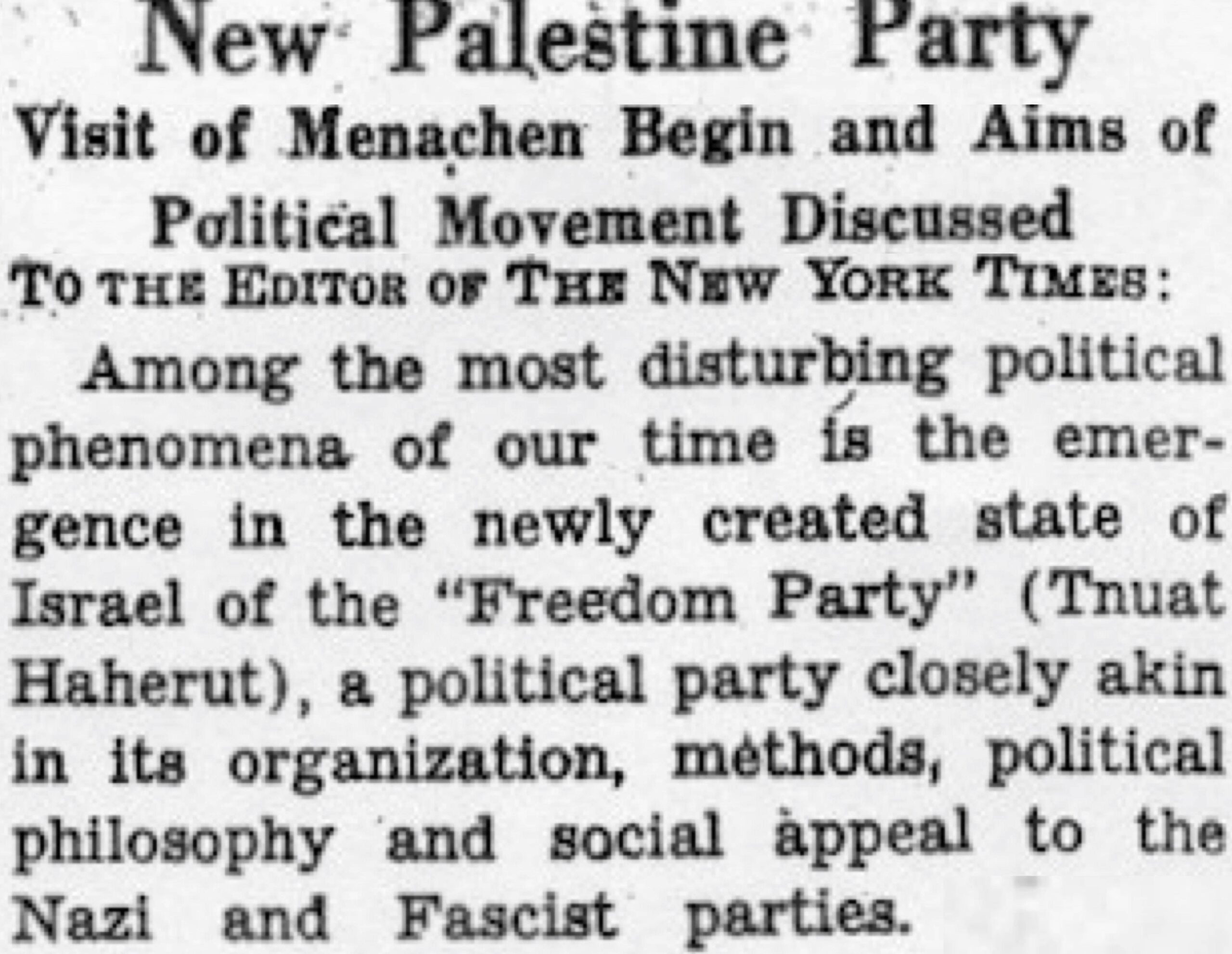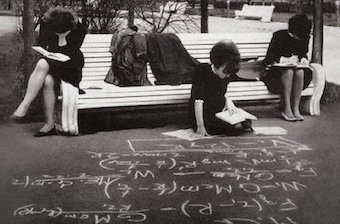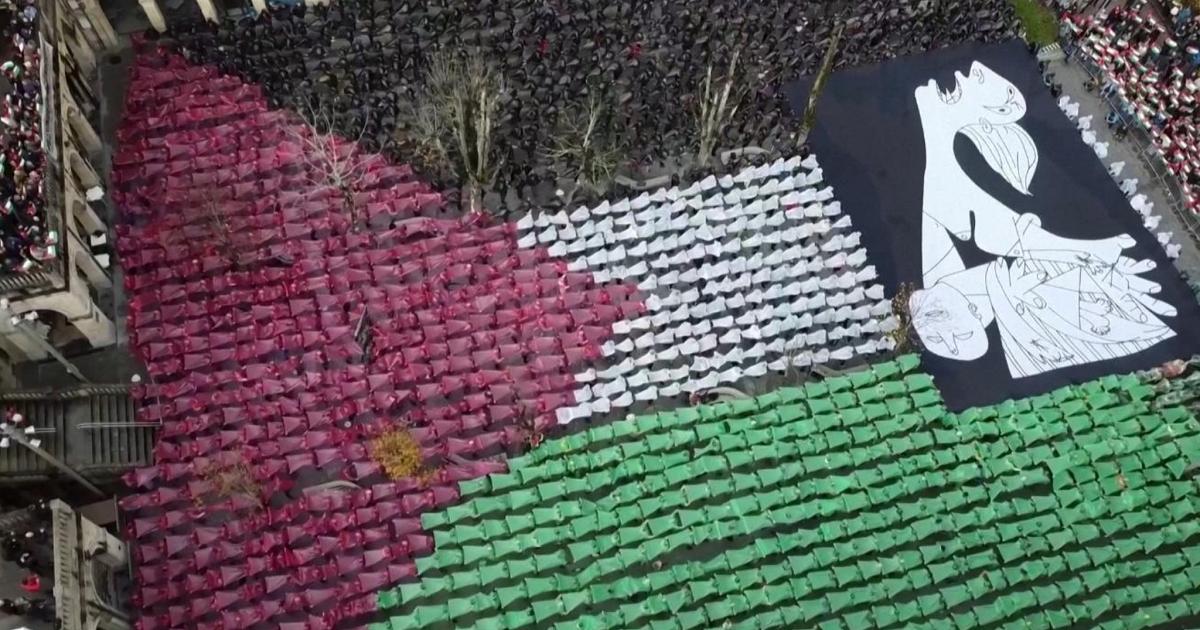
Gernika/Guernica, Euskadi, December 9, 2023. Thousands of protesters arrange themselves to form the Palestinian flag next to a detail of Guernica, Picasso’s painting denouncing the bombing of the city (1937).
[WM: We were editing this article when, on June 13, the Israeli armed forces launched Operation ‘Rising Lion,’ striking numerous targets in Iranian territory. The escalation in Western Asia – ‘Middle East,’ after all, is a Eurocentric expression of colonial origin – and the direct confrontation between the Likud regime and that of the Ayatollahs, along with the IDF’s destruction of Gaza’s last Internet connection, have temporarily overshadowed the ongoing genocide in the Strip, but the situation remains as described by Girolamo De Michele. The latest developments not only do not undermine the analyses and reflections that follow, but strengthen them.]
by Girolamo De Michele *
0. Premise
The total death toll is almost impossible to determine, but it must be attempted in some way; there are the victims reported by the Gaza Ministry of Health, considered reliable by international organizations; to which we must add the dead still buried, who may never be unearthed; and the dead from consequential causes – long-term injuries, illness, malnutrition. A study published in The Lancet last July – when the estimated death toll was around 37,000, just under half of the count at the moment I am writing, plus 10,000 under the rubble according to UN estimates – stated:
«Even if the conflict ends immediately, there will continue to be many indirect deaths in the coming months and years from causes such as reproductive, communicable, and non-communicable diseases. The total death toll is expected to be large given the intensity of this conflict; destroyed health-care infrastructure; severe shortages of food, water, and shelter; the population’s inability to flee to safe places; and the loss of funding to UNRWA, one of the very few humanitarian organisations still active in the Gaza Strip.
In recent conflicts, such indirect deaths range from three to 15 times the number of direct deaths. Applying a conservative estimate of four indirect deaths per one direct death to the 37 396 deaths reported, it is not implausible to estimate that up to 186 000 or even more deaths could be attributable to the current conflict in Gaza. Using the 2022 Gaza Strip population estimate of 2 375 259, this would translate to 7·9% of the total population in the Gaza Strip.»
1. The word genocide exists because…
Ten deaths, in this situation, are a drop in the ocean. But even a drop matters if it can reflect the sea and allows, as an exemplary case, to describe the universal. On May 24, a targeted bombing of a home where a couple of doctors alternated between home and hospital killed nine of their ten children, and after three days of agony, the father. The mother saw the charred bodies of her children pass before her in the hospital where she works as a pediatrician.
Matteo Nucci, a renowned classicist who, since the beginning of the Palestinian genocide, has dedicated his expertise to interpreting the horror, has written about the Niobe – the mythological character whose twelve children were exterminated by Apollo and Artemis – of Gaza, translating a text published in Greece.
«Of the ten children of Niobe of Gaza, nine were not killed by arrows, but by a bomb. The youngest was six months old, the oldest twelve years. And it was not the mother’s hubris that caused their death, but the simple fact of their existence, the fact that at the moment of the disaster they were in their home in Khan Younis, having not obeyed the order to evacuate the area declared a ‘dangerous war zone’ by the Israeli army.».
The evacuation order, moreover, had been revoked in the area where the two doctors’ house stood. Thus, we have a massacre of civilians, among whom are two doctors and ten children. And a pack of deniers that for two days has loudly shouted «fake news!» This is enough to begin writing about this genocide.
But right on the brink of beginning, there is the classic elephant in the room: the word ‘genocide’; indeed, two elephants, since alongside the first is the word ‘antisemite’. Two words that, paraphrasing semiologist Valentina Pisanty, are, like the entire political and cultural debate after October 7, 2023, ‘hostages to a militarization and a serious confusion about what antisemitism is, what anti-Zionism is,’ as well as what genocide is (cf. V. Pisanty, Antisemita. Una parola in ostaggio, Bompiani, Milan 2025).
‘Genocide’ is a word that defines a specific crime and a related legal concept. Francesca Albanese, who has played a fundamental role for years as the Special Rapporteur on human rights in the Palestinian territories occupied since 1967, expressed this very well: ‘Apartheid and genocide are not scandalous words: they are crimes. It is scandalous to tolerate them.’

Raphael Lemkin (1900 – 1959)
As is (apparently) known, the term ‘genocide’ was created by the Polish-Jewish jurist Raphael Lemkin in his book Axis Rule in Occupied Europe (1944): an impressive collection of ‘crimes without a name,’ that is, lacking an adequate legal concept to be defined, that were being committed in Europe under Axis rule.
An important point: while the role of the Nazi occupying army and administration is predominant, Lemkin investigated the crimes committed by all the Axis forces, including Italy. Against the Jews, and Polish Jews, certainly; but Lemkin does not limit himself to the Jews of Eastern Europe, and details a long list of national groups victimized by genocide in Czechoslovakia, Alsace and Lorraine, Greece, Luxembourg, Poland, Russia, Slovenia, Albania, France (French Jews), Belgium, and Macedonia; he also documents the genocidal actions in Serbia against Serbs, Jews, and Roma; and notes the crimes of the Italian occupying army against the Croatian population.
Lemkin wrote the book after verifying how the documented knowledge, already in 1942, of Nazi crimes in Europe left Western leaders Roosevelt and Churchill indifferent: Lemkin himself received no response to a report sent to Roosevelt, just as Jan Karski, who had managed to obtain a meeting with the U.S. president, did not. Among the many comparisons made in recent months, often with the intent to deny the analogy between the genocides perpetrated during World War II and the one currently occurring in Palestine, this should instead be emphasized: even in 1942, it was not ‘the world’ – a phrase that means nothing – but the Western governments that were aware of what was happening, at least through the denunciation books published by the Polish government in exile in London and by the Jewish Socialist Bund (which Lemkin used). And they turned their heads elsewhere, practicing what has been called ‘the statecraft of carefully calibrated compassion’.
Lemkin provides the following definition of his neologism:
«By “genocide” we mean the destruction of a nation or an ethnic group […] Generally speaking, does not necessarily means the immediate destruction of a nation, except when accomplished by mass killings of all members of a nation. It is intended rather to signify a coordinated plan of different actions aiming at the destruction of essential foundations of the life of national groups, with the aim of annihilating the groups themselves.»
From this page of chapter IX of Axis Rule, up until December 9, 1948, there is a long history that I cannot summarize here; therefore, I will limit myself to the definition of ‘genocide’ provided by Article 2 of the Convention on the Prevention and Punishment of the Crime of Genocide:
«Genocide means any of the following acts committed with intent to destroy, in whole or in part, a national, ethnical, racial or religious group, as such:
(a) Killing members of the group;
(b) Causing serious bodily or mental harm to members of the group;
(c) Deliberately inflicting on the group conditions of life calculated to bring about its physical destruction in whole or in part;
(d) Imposing measures intended to prevent births within the group;
(e) Forcibly transferring children of the group to another group.»
Article 2 of the Convention should serve as the common point of reference from which one can sensibly argue for or against the appropriateness of linguistic usage. However, this linguistic usage points to international law and its instruments, at least starting from the trials that condemned those responsible for the genocides in Bosnia and Rwanda, in application of the 1948 Convention. Without this common guiding star, one ends up falling into a sort of DIY genocide, participating, willingly or unwillingly, in that plague of language that Italo Calvino denounced in Six Memos for the New Millennium: because if the plague makes us unable to understand words and share their meaning, if the relationship between human beings is not mediated by language, then linguistic mediation is replaced by the mediation of ferocity, the human condition falls back into barbarism, and thought becomes a powerless contemplation of dehumanization, as Franco ‘Bifo’ Berardi recently wrote in Pensare dopo Gaza. Saggio sulla ferocia e la terminazione dell’umano, Timeo 2025.
The word ‘genocide’ exists because genocides do exist: for this reason, it is necessary to use precise words to name them, also considering the performative use of language by international tribunals and courts when they issue judgments.
Even if the Shoah played a significant role in guiding the United Nations toward the far from obvious approval of the Convention, the definition of ‘genocide’ intentionally contains no reference to the Shoah or to other genocidal events that have occurred – from Palestine’s Nakba to the pogroms by Hindu extremists against Indian Muslims in 1947-48, which were also mentioned in the discussions leading to the approval of the Convention. Just two hours before the approval, Poland and Czechoslovakia proposed a final amendment, seeking to include a reference, albeit generic, to the events of World War II, but it was rejected. In Lemkin’s words:
«genocide is not an exceptional phenomenon, but [. . .] occurs in intergroup relations with a certain regularity like homicide takes place in relations between individuals.»
Ten year earlier, Lemkin himself had conceived the need for a norm of international law – what is now called International Humanitarian Law – to prevent and punish this crime, which in 1933 he referred to as ‘barbarism’ (the equivalent of genocide) and ‘vandalism’ (the destruction of the basic elements of a group’s cultural and national identity). [1].
Even further back, already in the 1920s, after two political assassinations where Talaat Pasha, one of the Turkish perpetrators of the Armenian genocide, was shot by an Armenian revolutionary (in 1921), and the former Ukrainian Prime Minister Symon Petliura, one of the highest-level perpetrators of the pogroms against Jews during the civil war of 1918 was killed by a Jewish anarcho-Bolshevik student (1926), in the Yiddish newspaper Haynt Lemkin used the expression ‘beautiful crime’ [sheyne farbrekhens], nonetheless he argued that the legitimate demand for justice for crimes against humanity could not be accomplished through individual revenge, even if morally right, but must find a supranational venue that would prevent the national law of states from allowing such crimes to go unpunished.
It is worth noting that Lemkin, by the mid-1950s, had strengthened his conviction – which dated back several years – about the close relationship between genocide and settler colonialism, seeing an exemplary case in the ongoing genocide in Algeria by French settlers. During those years – before he suddenly died of a heart attack in 1959 – Lemkin established a collaborative relationship with the Palestinian diplomat (born in Khan Younis) Muhammad el-Farra, with whom he worked to denounce French colonial crimes. At that time, el-Farra was the representative of Arab States at the UN; ten years later, as the UN ambassador for Jordan, he would denounce the American genocide in Vietnam and the Israeli genocide in Palestine:
«How can we, the delegation of Jordan, a small member of the United Nations, find a mild and calm language to describe the American napalm bombs used by the Israelis against our people and our heroic little army, which fought without adequate machinery, without air cover, but with every sacrifice, with all courage, with manhood and determination? And with this and many other Israeli atrocities, how can we find an excuse for American politicians who, for cheap political gains, exploit the suffering and losses inflicted on us and the acts of genocide committed against our people?» (June 13, 1967)
Likud? A fascist party, said Primo Levi
The second armed elephant overseeing the public debate is the accusation of antisemitism, often supported by the false equation anti-Zionism = antisemitism, which hides many other arbitrary equivalences in that apparent sign ‘=’. ‘Jew’ and ‘Zionist’ are not synonyms; nor are ‘Israeli’ and ‘Jew,’ as there are Israelis whose Arab-Palestinian origin is a reason for discrimination motivated not by what (hypothetically) one does, but by what one is: for example, taking a plane as an Israeli Palestinian citizen means undergoing a humiliating personal search that includes stripping and anal and genital inspection.
It must be said that the argumentative context is, most of the time, toxic, due to the aforementioned plague of language. A context that has murky roots – the excluding rituality of the ‘Days of Remembrance,’ with their ‘guardians,’ for example: a battleground on which Valentina Pisanty has been engaged for years. We can certainly agree with her in asserting that ‘anti-Zionism is expressed in many ways,’ and ‘most of these positions have nothing to do with antisemitism.’ But we can also state that the question of what Zionism is, was, wanted to be, and has become – and the inevitability or not of its deviations – is a question that we can set aside today, because ‘Zionist’ is too broad and imprecise a definition to designate Likud, its political genealogy, and its current leadership.
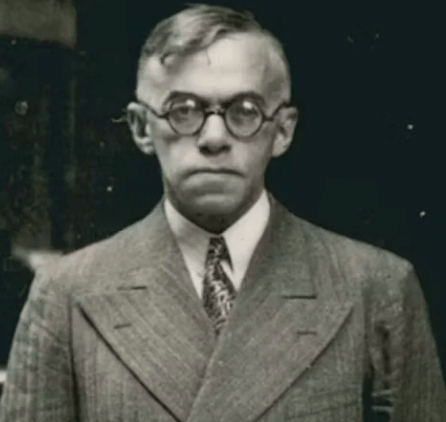
Fascista: Ze’ev Jabotinsky (1880 – 1940)
Likud descends by direct lineage from a far-right faction of 1920s Zionism, that ‘wing of fascist Zionism that adopted the Nazi salute’ (words of Amir Goldestein, in Haaretz), whose main representative was Ze’ev Jabotinsky, an admirer and friend of Mussolini, from whom he received as a gift a radio station in Civitavecchia, Italy.
That Jabotinsky was a fascist, and that his heir Menachem Begin, founder of Likud, can rightly be called a fascist, was stated clearly by Primo Levi:
«For Begin, “fascist” is a definition I accept. I believe that Begin himself would not reject it. He was a disciple of Jabotinsky: the latter headed the right wing of Zionism, proclaimed himself a fascist, and was one of Mussolini’s interlocutors. Yes, Begin was his disciple.» [2]
Not by chance was Jabotinsky expelled from Haynt, the Polish Yiddish newspaper where Lemkin wrote, when he began to express his fascist ideas.
While Levi labeled Begin a fascist during the 1980s, Hannah Arendt and Albert Einstein, along with dozens of Jewish intellectuals who had emigrated to the US, went much further on December 2, 1948 – a week before the approval of the UN Convention on Genocide. In an open letter published in the New York Times, they did not hesitate to compare Begin to Hitler, describing his Freedom Party (Tnuat Haherut) as ‘a political party closely akin, in its organization, methods, political philosophy, and social appeal to the Nazi and Fascist parties.’ The signatories of the letter mentioned the terrorist massacre of Deir Yassin as an exemplary case for a party that did not hesitate to use terrorist means against Arabs, English, and Jews to impose its goal of an oppressive state for minorities.
As for the current Israeli ruling class, the exact term is likudnik, as an expression of a totalitarian and colonial political conception that legitimizes apartheid and ethnic cleansing on political and racial grounds, even before it manifests in practice. Just as likudnik are its supporters in Italy: among whom there are those who, well before October 7, advocated for the necessity of deporting Palestinians from the West Bank and implementing a boots-on-the-ground policy in Gaza, and who do not hesitate to label Primo Levi himself as a ‘useful idiot’ or a ‘self-hating Jew.’
If they are our friends, it is not genocide
What constitutes genocide and what does not is not determined by the greater or lesser proximity to the Shoah, nor by the greater or lesser distance of the State of Israel from the Third Reich; there is no quantitative threshold either: however horrible it may be to say, the numbers of the Srebrenica genocide are proportionally very low compared to other massacres: yet a ruling by the International Court of Justice recognized the massacre of the Bosniak Muslim community carried out by Serbian-Christian militias as genocide; nor is there a peculiar operational procedure, since genocidal methods change with the times.
What constitutes genocide is defined by a UN Convention signed by over 150 nations, not by sympathy or political proximity to the state that commits it; nor does it matter whether those responsible are ‘autocrats’ or have been ‘democratically elected.’ This should be a trivial matter, but in public discourse, as well as in political discourse, it is not. This is evidenced by the fact that William Schabas felt the need to clarify it in an interview with the online magazine The New Arab.[3]
Schabas is one of the most authoritative, if not the most authoritative, global experts on international humanitarian law, and particularly on genocide; his book Genocide in International Law: The Crime of Crimes (whose subtitles echoes Lemkin’s definition of ‘crime of crimes’) is considered an essential commentary on global legislation regarding genocide. Schabas, having more courage than many of his academic colleagues – or perhaps, as he wryly points out, being of a certain age – denounces the moral blackmail and the risk of academic retaliation for those who venture to clearly say the word ‘genocide.’
Yet this word must be spoken, not only for the duty – not only for those who define themselves as writers – to say things as they are, without omitting anything. The ongoing genocide in Gaza is just one aspect of a broader attack on international institutions – starting with the UN and its agencies, to the Courts of Justice that give expression to the Convention (which would otherwise remain a mere statement of principle), to the very existence of International Humanitarian Law, whose existence is inseparable from the recognition that some crimes cannot be legitimized by the sovereign law of the state that commits them, or protects those who commit them. In the words of Italian-Palestinian journalist Rula Jebreal: ‘Palestine is the canary in the coal mine of the new global authoritarianism,’ of the new Western imperialism. This is what is at stake.
The definition of genocide in the 1948 Convention does not only contain a list of acts but also a crucial term to distinguish genocide from other international crimes – war crimes, crimes against peace, or crimes against humanity: ‘intent’.
On a legal level – and thus regarding what could happen in international Courts of Justice when these acts are prosecuted – everything revolves around the concept of intentional act. By intentional act, we can distinguish between widespread behaviors that have preliminary influences the context, and are at the same time an indicator and a first step in the genocidal process; and acts that are internal to the genocidal action itself, which point to a specific intent.
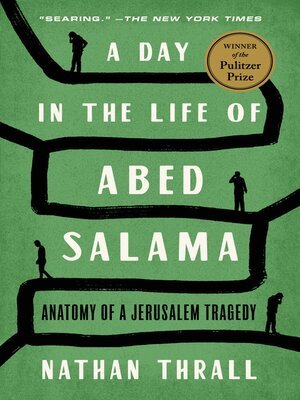
In the first category, we can place ethnic cleansing and apartheid.
The former is not classified as an international crime, not because it is permitted, but because it is difficult to distinguish it from an ongoing genocide, or it signals the beginning of an escalation that will culminate in genocide. That the Nakba is characterized as ethnic cleansing is a fact acknowledged even by some of the Israeli historiography: not only historian Ilan Pappé, but also his colleague Benny Morris (whose political trajectory, from criticizing Zionist colonialism to supporting the current government, speaks volumes about the transformations in Israeli society).
Apartheid, on the other hand, is a crime enshrined in the Rome Statute: this would be enough to review its case law and compare it with the military laws in force throughout the West Bank to see the obvious correspondences. Alternatively, one could read Nathan Thrall‘s novel A Day in the Life of Abed Salama (Pulitzer Prize 2024), which starts from a news event – a traffic accident involving a school bus and a parent trying to reach the hospital to find out if his child is among the living or the dead – to understand how being a Palestinian from the West Bank or East Jerusalem equates to being a second-class human being devoid of universal rights and subjected to a despotic power simply for being who they are – a life unworthy of living, a lebensunwerte Leben.
In the interregnum between these two criminal acts – but also between the two semantic areas into which genocidal intent is divided – lies the monstrosity of the Other, that is, the Palestinian. This is a process defining a superior identity and a corresponding inferior identity, which begins as early as the basic school manuals and extends into the implicit and explicit aspects of social life. Part of this process of monstrosification is the creation of false news about October 7, true hyperboles of horror, narrative excrescences grafted onto the actual horror of the massacres.
The fact-checking of these claims has been carried out, in a professional and accurate manner, by the critical Israeli press, by historians like Lee Mordechai, author of a report updated to version 6.0 (July 2024), and by independent journalists.[4] For example, the claim of 40 decapitated children or the execution of children in front of their parents is false, even though these reports were initially presented as true – only to be later retracted – by former US President Joe Biden.
The very recourse to mass rape as a war crime is still sub judice, as evidenced by the fact that not a single criminal proceeding has yet been opened by the Israeli justice system. Meanwhile, Israel, which refuses to provide the alleged evidence it claims to possess, as well as refusing consent for an independent international investigation, has replaced the voice of the women victims of the October 7 pogrom with its own voice, the voice of the State: it has appropriated the voices of the victims to speak on their behalf, which indeed is a form of rape.
The creators of these fake news have been militant propagandists, such as the self-proclaimed ‘eyewitness’ Shari Mendes; but above all, an extremist association, ZAKA (whose founder, Meshi Zahav, was forced to resign in 2021 under accusations of having raped six individuals, both men and women).
ZAKA is not an isolated case: investigations conducted by the independent Israeli press have demonstrated the existence of a network of Likudnik (or even further to the right) groups. Through an independent investigation, FakeReporter, an organization of information activists, has shown the existence of a network of fake platforms – Non-Agenda, The Moral Alliance, and Unfold Magazine – that, through hundreds of fake profiles, directed public opinion in favor of the government. The defamatory campaign against UNRWA workers, accused of being involved in the October 7 massacre, is their most successful creation.
If you don’t believe the Palestinians, believe the American doctors working in Gaza
Intentional acts inherent to genocide include the targeted killings of entire categories: teachers, journalists, and doctors. But also – and this is a new aspect that must be taken into account – the algorithmic (though directed by humans) programming of AI systems. The military application of platforms and companies that analyze data through AI, with lucrative contracts for Israel, is an activity that has enriched some «anarcho-capitalists» who now present themselves as a new elite of political power in the US.
In particular, as revealed by an investigation conducted by several Israeli publications, there is a program in use in the Israeli army, called Habsora (‘The Gospel’), that can generate targets almost automatically; one of the IDF soldiers interviewed stated:
«Nothing happens by accident. When a 3-year-old girl is killed in a home in Gaza, it’s because someone in the army decided it wasn’t a big deal for her to be killed — that it was a price worth paying in order to hit [another] target. We are not Hamas. These are not random rockets. Everything is intentional. We know exactly how much collateral damage there is in every home.»
There are no collateral damages; there are intentional targeted killings and consequential damages. Among these is the entire educational system in the Gaza Strip. In the words of the oldest and largest historical society in the United States, the American Historical Association, which voted in early 2025 on a powerful document denouncing and condemning:
«The IDF’s destruction of 80 percent of schools in Gaza, leaving 625,000 children with no educational access;
The IDF’s destruction of all 12 Gaza university campuses;
The IDF’s destruction of Gaza’s archives, libraries, cultural centers, museums, and bookstores, including 195 heritage sites, 227 mosques, three churches, and the al-Aqsa University library, which preserved crucial documents and other materials related to the history and culture of Gaza;
The IDF’s repeated violent displacements of Gaza’s people, leading to the irreplaceable loss of students’ and teachers’ educational and research materials, which will extinguish the future study of Palestinian history;»
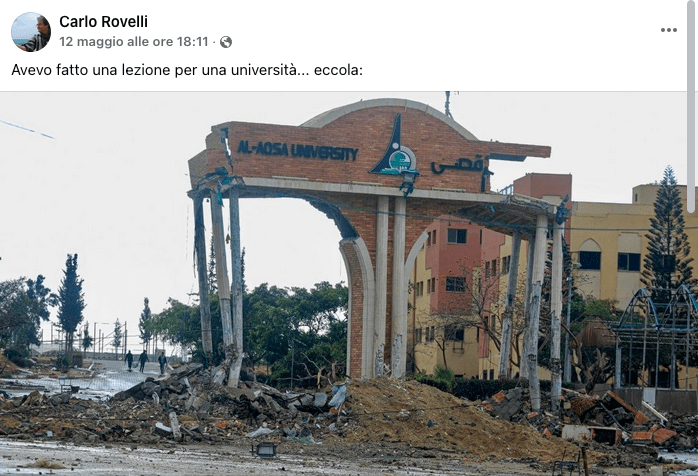
«I gave a lecture at a university. Here’s how it is now.»
The list is unfortunately incomplete: it lacks the targeted killings of all Palestinian faculty heads. Regarding the targeted killings of journalists and media workers – over 200 – there is very little to say, aside from the cowardice and timidity of a good part of the Italian press, which has crouched at the edges of genocide, consciously playing the role of ‘media escort to the massacres’ – words from the denunciation by Raffaele Oriani, who left Repubblica after 12 years for this reason; except that their slaughter, aimed at preventing access to the truth, effectively transforms doctors and healthcare workers into bearers of truth as frontline witnesses. This also explains the targeted killings of doctors, or their abductions, detention without justification, and torture (when they are not assassinated): to the point that they strip off their lab coats and identifying marks of their profession before leaving the hospital clinics, so as not to be identified by snipers.
The Israeli state has never provided any evidence of the alleged connections between hospitals and Hamas bases, or of the military use of underground tunnels (some of which were actually created by the Israeli occupation in the past). And when it tried to do so, it was contradicted by international media outlets[6]: which do exist, and unlike the Italian ones (with some exceptions), verify the information coming from Palestine with their own sources (including news agencies) – and, as is obvious, they state this.
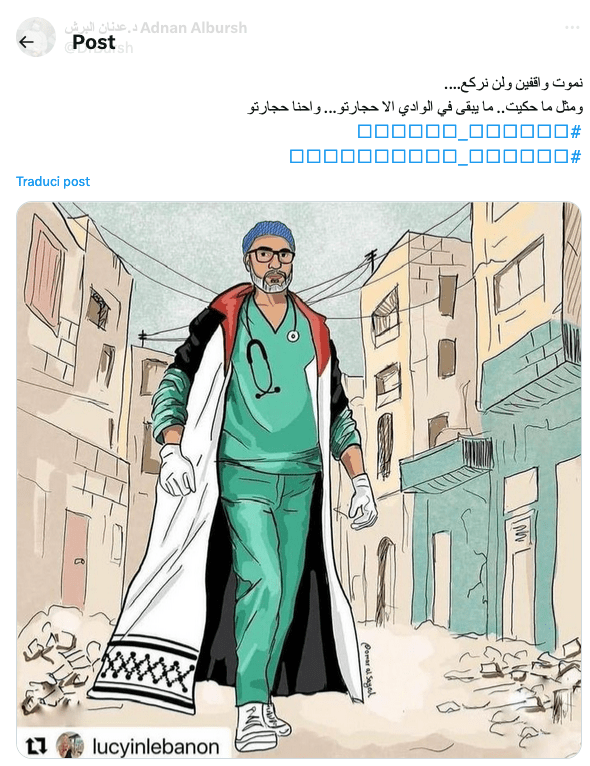
Over a thousand healthcare workers – doctors, nurses, volunteers – have been assassinated since October 7, 2023, in the Gaza Strip. Among them is Adnan al-Bursh, a renowned orthopedic surgeon, who was kidnapped along with ten other colleagues while he was operating in the Jabalya refugee camp in December 2023, then illegally detained in the notorious torture center of Sde Teiman – the Israeli ‘Garage Olimpo’ in the Negev desert – and declared dead on May 2, 2024. The detained doctors are tortured to extract confessions of alleged connections with Hamas; but al-Bursh did not yield. A month before he was kidnapped, he published a final post on X, in which he wrote (in Arabic): ‘We will die standing, not on our knees. All that remains in this valley are its stones, and we are its stones.’
The fate of Hussam Abu Safiya, who also passed through Sde Teiman and had refused to evacuate the hospital even after the targeted killing of his son Ibrahim, remains unknown. The last image we have of him as a free man shows him walking alone towards an Israeli tank: the Palestinian equivalent of the boy with the buckets standing in front of the Chinese tanks in Tiananmen Square.
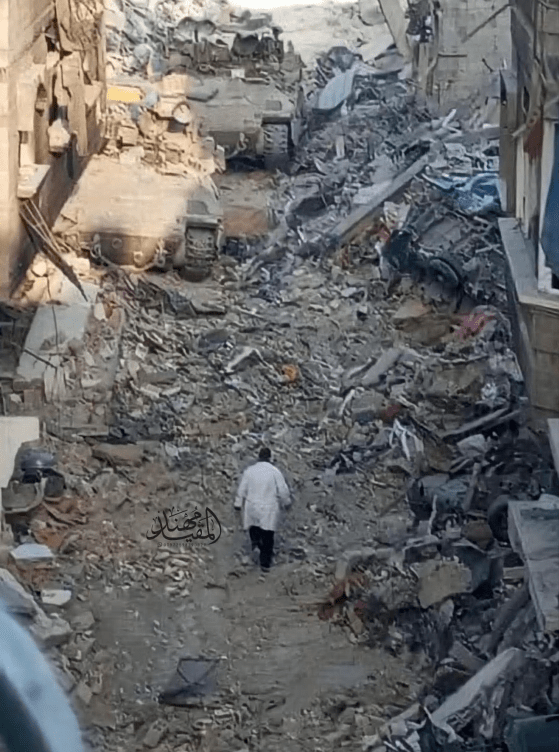
‘If you do not believe the Palestinians, believe the American doctors working in Gaza’: this is a phrase that underlies the many investigations and testimonies of American and European doctors who volunteer in war zones – from Afghanistan to Syria, Iraq, and Sudan. [8].
The most comprehensive and chilling investigation is the one conducted by a group of 65 volunteer doctors led by California physician Feroze Sidhwa, published in the New York Times on October 9, 2024; he is also the author of a denunciation alongside Mark Perlmutter, a war doctor from North Carolina, who became inadvertently famous for having saved the life of a future senator in Iraq; and also Adam Hamamay, Mimi Sayed, and pediatrician Tanya Haj-Hassan.[9] What emerges from their testimonies is that ‘together, Israel and the United States are turning Gaza into a screaming desert’; these are the words of the 65 doctors featured in Feroze Sidhwa’s investigation, who conclude: ‘The horror must end. The United States must stop arming Israel. And after that, we Americans will have to undertake a long and hard self-examination within ourselves.’
One of the data collected by the doctors is the regularity with which children, already dead or dying, arrive at the hospitals, having been struck by single bullets to the head: if it were an isolated case, if it were a ‘collateral effect,’ it would not happen so frequently, day after day. And if the victims had happened to be caught under enemy fire, they would not be single bullets.
In the case of the investigation by the 65 doctors, the New York Times published three X-ray images of children’s skulls with a bullet inside; in response to a series of letters claiming that the story was false, the NYT stated that the newspaper had verified that all the doctors and nurses had worked in Gaza; that the images had been sent to independent experts in gunshot wounds, radiology, and pediatric trauma, who confirmed the authenticity of the images; and that the photos of the children had been compared with the digital metadata of the images. In approving the publication of the investigation, the NYT specified that it possessed photos that corroborated the X-ray images but had chosen not to publish them because they were ‘too horrific’.

The deliberate killing of children is one of the means by which the State of Israel is erasing a people from its land. This is why the assassination of nine children and their father, children of a couple of doctors, in their home is an exemplary case: because all types of genocidal intent converge in that house destroyed by a missile launched from an IDF drone. This explains the denial campaign, mixed with the sexist and Islamophobic lynching of the mother, Alaa: denying the bombing of the al-Najjar family’s home implies that such an event could not have occurred because the IDF does not kill doctors and children – despite the fact that the BBC has verified the reliability of the video provided by the Gaza Ministry of Health [‘A video shared by the director of the Hamas-run health ministry and verified by the BBC showed small burned bodies lifted from the rubble of a strike in Khan Younis’], and supported the information with interviews with some British doctors working in the hospital where Alaa al-Najjar witnessed the charred remains of her nine children, her husband on the brink of death, and the only surviving son.
Dostoevsky wrote that the suffering of a single child – just one: not tens of thousands – is an intolerable price, and its scandal calls into question the very existence of God, in whom he believed; while he did not believe in the devil, except as a creation of human beings. And today the devil, whatever it may or may not be, appears to be an amateur compared to human beings – because they are human, not ‘beasts’: this is one of those cases where it is forbidden to diminish the horror produced by humans using metaphors and comparisons to the animal world – capable of intentional planning of crimes that call into question that very God in whom they claim to believe.

«Let’s be aware of this: it’s like living in a (global) village near an extermination camp in 1944, and looking, powerlessly, at the dark smoke rising from those chimneys.»
A genocide broadcast worldwide: and we, as inhabitants of a house overlooking Auschwitz, see the smoke rising from the chimneys from our garden. The sacred, legitimate indignation that this vision evokes, especially in generations that have only heard about Vietnam – but for this reason, it is right to say that Gaza is ‘their Vietnam’ – stands in stark contrast to the indifference and apathy with which another part of global public opinion passively accepts, if not legitimizes, the ongoing genocide.
It is essential to ask where this acquiescence may lead, what consequences may arise from crossing a moral threshold that was thought to be impassable, and what Pandora’s box[10] has been opened.
Notes
1. That ‘cultural genocide’ which was not included in the Convention, but which has inspired legal concepts such as ‘educide’ or ‘scholasticide,’ to define the Israeli practice of destroying educational and cultural institutions and the targeted killings of Palestinian faculty members during the many aggressions carried out against the Gaza Strip.
2. Primo Levi, «Io, Primo Levi, chiedo le dimissioni di Begin» [I, Primo Levi, demand the resignation of Begin], interview with Giampaolo Pansa, La Repubblica, 24 september 1982, now in Opere Complete, vol. III, edited di Marco Belpoliti, Einaudi, Turin 2018, p. 306.
3. Cf. also the interview «Immunity or impunity? International justice after Gaza», especially from 41:25.
4. «Hamas Committed Documented Atrocities. But a Few False Stories Feed the Deniers», Haaretz;
Lee Mordechai, «Bearing Witness to the Israel-Gaza War»;
«Israel says Hamas weaponised rape. Does the evidence add up?», The Times;
«How 2 debunked accounts of sexual violence on Oct. 7 fueled a global dispute over Israel-Hamas war», Associated Press;
Rula Jebreal, Genocidio. Quello che rimane di noi nell’era neo-imperiale, Piemme 2025, cap. 4: «La guerra contro la verità dei fatti» [War against the truth of facts].
5. «Israeli Influence Operation Targets U.S. Lawmakers on Hamas-UNRWA», Haaretz. The complete Pro-Israeli Influence Network report is here.
7. Cf. “Punire chi protegge le vite” [To punish those who protect lives] in Rula Jebreal, Genocidio, cit.
8. ‘Nobody cares about Sudan!’, ‘Why don’t you talk about Sudan?’, this is what our Likudnik denialists scream. It goes without saying that, in addition to war doctors, humanitarian organizations – from Doctors Without Borders to Emergency – are present in Sudan, and they have been discussing it in their publications for years. But certain denialists who cannot distinguish Sudan from Darfur are like the phony character in the Boris TV series, who claimed to be donating his fee to Darfur but was unable to tell where it was, and got by saying that ‘Darfur is within us’.
9. Feroze Sidhwa, «65 Doctors, Nurses and Paramedics: What We Saw in Gaza», New York Times, Oct. 9, 2024;
Mark Perlmutter and Feroze Sidhwa, «We Volunteered at a Gaza Hospital. What We Saw Was Unspeakable», Politico Magazine;
«Dr Adam Hamawy: I’ve Never Seen Devastation Like in Gaza», Jacobin;
Tanya Haj-Hassan, pediatra a Gaza: «È troppo tardi per tutti questi anni di ingiustizia», La7.
10. The metaphor of Pandora’s box referring to Gaza is from Chris Hedges, who, in addition to having compiled his reports in the recent A Genocide Foretold, is doing valuable informational work through The Chris Hedges Report.
* Girolamo De Michele (Taranto, 1961) lives and teaches in Ferrara. He collaborates with various magazines, both print and online, including Il manifesto, doppiozero, and estense.com. Among his publications are: History of Beauty, edited by and in collaboration with Umberto Eco (2004); La scuola è di tutti. Ripensarla, costruirla, difenderla (2010); Filosofia. Corso di sopravvivenza (2011); If the Kids are United. Musica e politica tra i 60 e gli 80, with Fant Precario (2017); and Un delitto di regime. Vita e morte di don Minzoni, prete del popolo (2023); as well as the novels Tre uomini paradossali (2004), Scirocco (2005), La visione del cieco (2008), Con la faccia di cera (2008), Le cose innominabili (2019), and Lo scacchista del diavolo (2023). He edited the three-volume autobiography of Toni Negri, Story of a Communist (2015-20).
–

